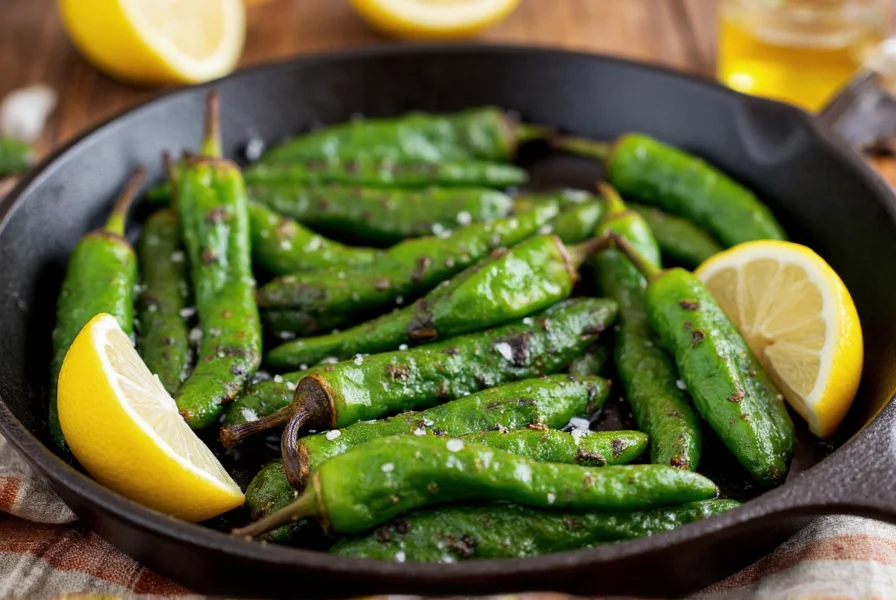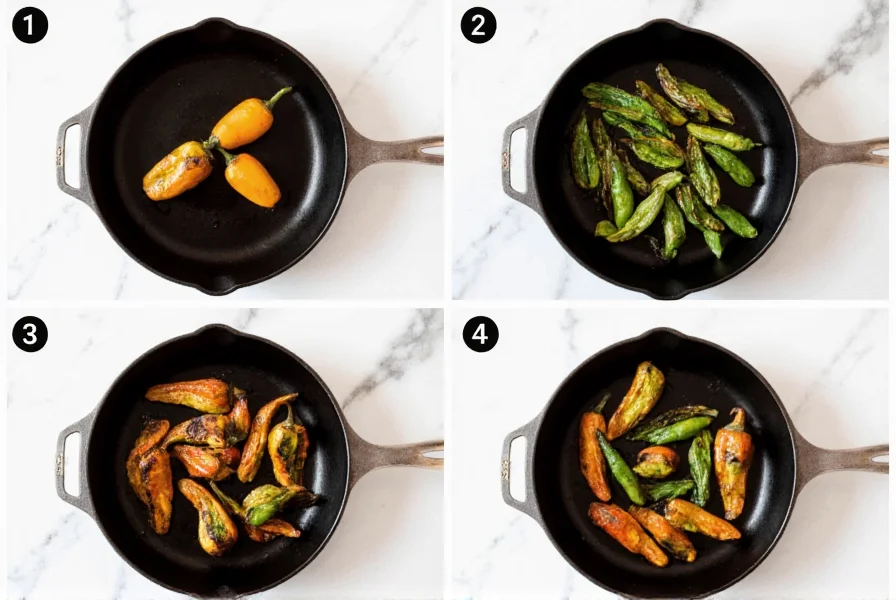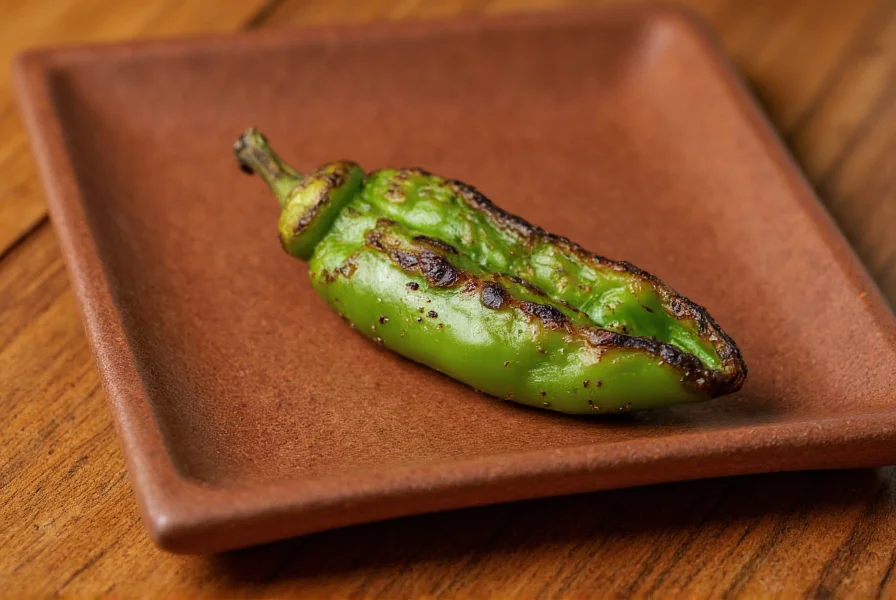The Art of Perfectly Blistered Shishito Peppers
Shishito peppers have transformed from a humble Japanese snack to a global culinary sensation, particularly when prepared using the blistering technique. These slender, bright green peppers measure 2-4 inches long and belong to the capsicum annuum species, but unlike their spicy relatives, they're predominantly mild with just an occasional hot surprise.
Blistering shishito peppers isn't just a cooking method—it's a flavor transformation process. When exposed to high, direct heat, the thin skin of these peppers chars quickly while the interior remains tender-crisp. This technique triggers the Maillard reaction and caramelization, developing complex flavor compounds that elevate their naturally sweet, grassy notes into something extraordinary.
Why Blistering Works Best for Shishito Peppers
The blistering technique perfectly complements shishito peppers' unique characteristics. Their thin walls and high water content make them ideal for this quick-cooking method. Unlike thicker peppers that might require longer cooking times, shishitos achieve that perfect balance of charred exterior and crisp-tender interior in just 3-5 minutes.
When properly blistered, shishito peppers develop:
- A delicate char that adds smoky complexity
- Concentrated sweetness from caramelized natural sugars
- Enhanced texture contrast between blistered skin and tender flesh
- Improved mouthfeel that makes them irresistible as finger food
| Preparation Method | Time Required | Flavor Result | Texture Result |
|---|---|---|---|
| Blistering (ideal) | 3-5 minutes | Smoky, sweet, complex | Crisp-tender with charred skin |
| Raw | 0 minutes | Grassy, vegetal | Crisp, slightly tough |
| Steaming | 5-7 minutes | Muted, bland | Soft, soggy |
| Deep frying | 2-3 minutes | Oily, less nuanced | Crispy exterior, mushy interior |
Step-by-Step Guide to Blistering Shishito Peppers
Mastering the blistering technique requires attention to detail but delivers restaurant-quality results at home. Follow these professional tips for perfect blistered shishito peppers every time:
Essential Equipment
You don't need specialized tools—just one of these heat sources:
- Cast iron skillet (best for home kitchens)
- Gas grill (ideal for authentic flavor)
- Broiler (good alternative when outdoor cooking isn't possible)
Perfect Blistering Technique
- Dry thoroughly—moisture prevents proper blistering
- Use high heat—450-500°F (230-260°C) for optimal charring
- Minimal oil—just enough to prevent sticking (1 tsp per pound)
- Don't crowd the pan—allow space for steam to escape
- Rotate frequently—every 30-60 seconds for even blistering
- Cook until 70% blackened—peppers should be mostly charred but not completely blackened
The entire process takes just 3-5 minutes. Overcooking turns these delicate peppers bitter and mushy, while undercooking misses the flavor transformation that makes blistered shishito peppers special.
Serving Suggestions for Blistered Shishito Peppers
Traditional Japanese preparation keeps things simple, but creative variations abound. The key is enhancing—not overwhelming—the peppers' delicate flavor profile.
Classic Preparation
After blistering, immediately transfer peppers to a serving dish and finish with:
- Fine sea salt (like Maldon)
- Fresh lemon or yuzu zest
- Optional: a light drizzle of high-quality olive oil or sesame oil
Creative Variations
While purists prefer the traditional preparation, these variations work well for different occasions:
- Umami boost: Light sprinkle of bonito flakes or shio koji
- Spicy kick: For those who enjoy heat, add a pinch of togarashi
- Chef's special: Finish with flaked sea salt and a squeeze of fresh lime
- Gourmet twist: Drizzle with truffle oil and shaved Parmesan

Understanding the Shishito Pepper Experience
What makes shishito peppers particularly exciting is their element of surprise. While 90% remain pleasantly mild, approximately 1 in 10 develops noticeable heat. This phenomenon relates to capsaicin distribution, which is influenced by growing conditions rather than genetics.
When blistering shishito peppers, keep these facts in mind:
- The heat level isn't predictable by appearance—spicy and mild peppers look identical
- Blistering doesn't increase the heat level of spicy specimens
- Stress factors during growth (like drought) increase the likelihood of spicy peppers
- Pepper heat is concentrated in the seeds and inner membranes
When serving blistered shishito peppers, consider providing a small bowl of aioli or yogurt dip for those who encounter the occasional spicy pepper. This thoughtful touch enhances the communal dining experience that makes these peppers so popular as shared appetizers.
Troubleshooting Common Blistering Issues
Even experienced cooks encounter challenges when preparing blistered shishito peppers. Here's how to solve the most common problems:
Problem: Peppers are steaming instead of blistering
Solution: Your heat isn't high enough or you've overcrowded the pan. Use maximum heat and cook in smaller batches with space between peppers.
Problem: Uneven blistering
Solution: Rotate peppers more frequently (every 30 seconds) and ensure your heat source is evenly distributed. Cast iron provides more even heating than stainless steel.
Problem: Bitter flavor
Solution: You've overcooked the peppers. Remove them from heat when they're about 70% blackened. The residual heat will continue the cooking process.

Seasonality and Selection Tips
For the best blistered shishito pepper experience, timing and selection matter. These peppers are at their peak from late summer through early fall, though greenhouse production makes them available year-round in most markets.
When selecting shishito peppers for blistering:
- Choose firm, bright green specimens with smooth skin
- Avoid peppers with wrinkles, soft spots, or yellowing
- Smaller peppers (2-3 inches) typically have better flavor concentration
- Freshly harvested peppers will have a slight sheen and crisp snap when bent
Store unwashed peppers in a perforated plastic bag in the refrigerator crisper drawer for up to 5 days. For optimal blistering results, bring them to room temperature before cooking.
Frequently Asked Questions
Can you eat blistered shishito peppers with the skin on?
Yes, the blistered skin is completely edible and adds desirable texture. The charred skin develops complex flavors during cooking and softens enough to eat comfortably. Many chefs recommend eating them skin-on for the full textural experience, though you can peel the skin if preferred.
What's the best oil for blistering shishito peppers?
Use a high smoke point oil with neutral flavor for blistering shishito peppers. Avocado oil (smoke point 520°F/270°C) or refined grapeseed oil (smoke point 420°F/215°C) work best. Avoid extra virgin olive oil which has a lower smoke point and can become bitter when heated to blistering temperatures. Use just enough oil to lightly coat the peppers—about 1 teaspoon per pound.
Why do some shishito peppers turn out spicy?
Approximately 1 in 10 shishito peppers develops noticeable heat due to environmental stressors during growth, not genetics. Factors like drought, temperature fluctuations, or nutrient deficiencies can trigger capsaicin production. This natural variation creates the 'gamble' that makes eating shishito peppers fun. The heat level isn't predictable by appearance—spicy and mild peppers look identical.
How do you prevent blistered shishito peppers from becoming soggy?
To prevent sogginess when blistering shishito peppers, ensure they're completely dry before cooking, use high enough heat (450-500°F), avoid overcrowding the pan, and don't cover the peppers while cooking. Immediately transfer blistered peppers to a serving dish rather than leaving them in the hot pan, as residual heat will continue cooking them. For best results, cook in batches if preparing large quantities.
What's the difference between blistering and roasting shishito peppers?
Blistering involves high, direct heat for a short time (3-5 minutes) creating charred spots while maintaining crisp-tender texture. Roasting typically uses lower, indirect heat for longer (10-15 minutes), resulting in more uniformly cooked, softer peppers. Blistering preserves the peppers' shape and delivers superior flavor complexity through controlled charring, while roasting creates a more uniformly cooked but less texturally interesting result. For shishito peppers, blistering is generally preferred to showcase their delicate nature.











 浙公网安备
33010002000092号
浙公网安备
33010002000092号 浙B2-20120091-4
浙B2-20120091-4